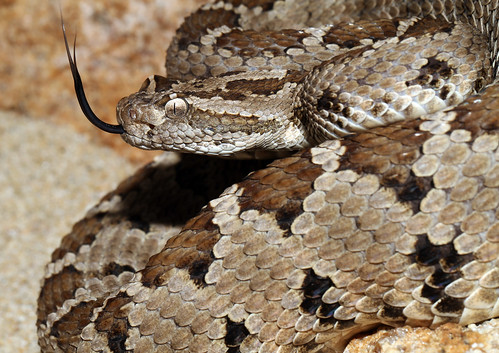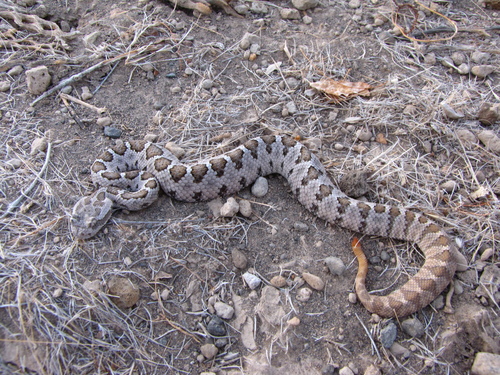Post by Ceratodromeus on Sept 16, 2016 5:06:15 GMT 5

Scientific classification
Kingdom: Animalia
Phylum: Chordata
Subphylum: Vertebrata
Class: Reptilia
Order:Squamata
Suborder: Serpentes
Family: Viperidae
Subfamily: Crotalinae
Genus: Crotalus
Species: C. enyo
At one point there were three subspecies, C.e.cerralvensis, C.e.enyo, & C.e.fuvus, regarded by early authors such as Cope(1861) as valid, have since been regarded as junior synonyms, or disregard for the lack of evidence. For example, Grismer(1999) writes that due to the overlap that "C.e.cerralvensis" overlapped with C.enyo, and thus the diagnosis presented by Cliff(1954)is not in fact diagnostic in regards to classification at all; examination of specimen coloration Cliff attributed to C.e.cerralvensis are not diagnostic either{1}. A similar case is apparent with the 'furvus' subspecies, a wide degree of sympatry with C.e.enyo, alongside very similar scale(namely ventral and subcaudal)counts, is not a very firm case for the diagnosis as a separate subspecies. Grismer(2002) writes that the three 'subspecies' are nothing more than color variation throughout geographic distribution. Mitchochondrial DNA analysis is needed to make this more clear, but said analysis is unlikely to happen any time soon.
Description
This is a mid sized species of rattlesnake; Laurence Klauber reported the smallest individual recorded at 20.7cm(8.1in) and he reported the largest recorded animal at 89.8cm in his book Rattlesnakes: Their Habits, Life Histories, and Influence on Mankind{2}, which was likely a female as he goes on to write the largest recorded male at 85cm(33in), likely an animal he reported in an earlier publication. Klauber reports the length of 14 adult animals "over 575mm in length", but elaborates no further{3}. In 2003 an article was published on the reproduction cycles of the baja rattlesnake, in which the sample contained 13 females and 31 males{7}. The mean snout-ventral length of the females featured in this article was 54.9cm(21.6in), with a range of 48.7-66.7cm(19.1-26.2in); The mean snout-ventral length of the male portion of the sample was 58.3cm(22.9in), with a range of 47-73cm(18.5- 28.7in).
This species is sometimes confused with the sidwinder(Crotalus cerastes, due to the hornlike scales above each eye. However, in the case of Crotalus enyo, these aren't really "horns" like we see in the sidewinder, but are instead large supraorbital scales. They are generally a light brown coloration with 30-40 dark brown blotches running down the dorsal surface of the animal. Animals attributed to the junior synonym C.e.cerralvensis possess a gray coloration that contrasts with the brown blotching. Approaching the vent, the blotching turns into banding and run approximately to the base of the tail. Ventral scale counts range from 157-181 between the sexes, with females generally possessing higher scale counts.

Geographic distribution & habitat use
As the common name may suggest, this species of rattlesnake can be found throughout Baja, California. The type locality was Cape San Lucas, and other localities specimens have been taken from include San Jose Del Cabo, San Bartolo, Miraflores, Santa Anita, San Pedro, Todos Santos, and Sierra de la Laguna{3}. They prefer arid areas with light foliage cover and/ or rocky areas{2}. These rattlesnakes are most often active from early March through November, in one locality the time of year they are most active is September through late October{5}.

Dietary habits & venom
Klauber(1931) wrote that the Baja rattlesnake eats mammals, but elaborated no further{3}. This has been substantiated in recent years with the analysis of stomach contents and fecal material examination from the cape region of Baja, California{4}. Out of twenty identified prey animals from twenty four snakes, 16 of these were the Spiny pocket mouse(Chaetodipus spinatus), two were Cape spiny tailed iguanas(Ctenosaura hemophila), one Hunsaker’s Spiny Lizard(Sceloporus hunsakerii), and an orange throated whiptail(Aspidocelis hyperythra). In 2001, in an analysis of 63 preserved specimens with food contents in the stomach, the majority of prey was mammalian in nature, making 60.3% of the records. The next most important prey were lizards, making up 33.3% of the records. Unusual for Crotalus rattlesnakes, 6.4% of the stomachs contained Scolopendra centipedes{4}. In an article on the conservation status of the San Jose brush rabbit(Sylvilagus mansuetus), the baja rattlesnake is mentioned as a predator, but the age class of the preyed upon individuals was not mentioned{6}.
The head is more slender in comparison with larger species, suggesting smaller venom glands. On this point however, Klauber suggests an average venom yield of 0.4g; He also writes that others report the median lethal dose for a 350g pigeon as 0.1mg, equally as potent as C.oreganus & C.atrox, and more potent than the tiger rattlesnake(C.tigris){3}. Klauber suggests that the baja rattlesake would be, as a result, a more dangerous animal over the tiger rattlesnake.
Reproduction
In regards to the reproductive biology of the species, not a lot of literature has been published. Klauber(1931) reports an adult female measuring 60.8cm(23.9in) collected in March contained(oviductal) eggs, but elaborated no further on the matter{3}. Grismer(2002) reported finding very young animals between July and October, varying from locality to locality. He put forward that mating would therefore be in the early spring, with young emerging in the early fall{6}. Taylor(1999), corroborated the idea that the young are born in the fall, but some may also be born in the spring. In a later publictation, Klauber reported litter sizes(as this species is live bearing) at six and nine, while captive animals have produced only one or two offspring{7}.
References
{1} Grismer, L. Lee. 1999. An evolutionary classification of reptiles on islands in the Gulf of California, México. Herpetologica 55 (4): 446-469
{2} Klauber, Laurence M. Rattlesnakes. Vol. 1. Univ of California Press, 1956.
{3} Klauber, Laurence Monroe. Crotalus Tigris and Crotalus Enyo: Two Little Known Rattlesnakes of the Southwest. Society., 1931.
{4} Taylor, Emily N. "Diet of the Baja California rattlesnake, Crotalus enyo (Viperidae)." Copeia 2001.2 (2001): 553-555.
{5} Grismer, L. Lee. Amphibians and reptiles of Baja California, including its Pacific islands and the islands in the Sea of Cortés. Vol. 4. Univ of California Press, 2002.
{6} Lorenzo, Consuelo, Sergio Ticul Álvarez-Castañeda, and Jorge Vázquez. "Conservation status of the threatened, insular San Jose brush rabbit (Sylvilagus mansuetus)." Western North American Naturalist 71.1 (2011): 10-16.
{7} Goldberg, Stephen R., and Kent R. Beaman. "Reproduction in the Baja California rattlesnake, Crotalus enyo." Bulletin of the Southern California Academy of Sciences 102.1 (2003): 39-43.


